|
|
| Missing In Action (MIA) | Prisoners Of War (POW) | Unexploded Ordnance (UXO) |
| Chronology | Locations | Aircraft | Ships | Submit Info | How You Can Help | Donate |
|
| USAAF 5th AF 312th BG 386th BS   Eliot Young 1944 |
Pilot 1st Lt. John M. Huber (resuced) Gunner SSgt Thomas Smith (resuced) Force Landed January 19, 1944 MACR none Aircraft History Built by Douglas Aircraft Company. Delivered to the U.S. Army Air Force (USAAF) as A-20G-20-DO Havoc serial number 42-86724. Disassembled and shipped overseas to the South West Pacific Area (SWPA) and reassembled at Townsville. Wartime History On January 14, 1944 assigned to the 5th Air Force (5th AF), 312th Bombardment Group (312th BG), 386th Bombardment Squadron (386th BS). No known nose art or nickname. No tail letter. Mission History On January 19, 1944 took off from Garbutt Field at Townsville piloted by 1st Lt. John M. Huber as one of six A-20s on a ferry flight via Horn Island Airfield bound for Port Moresby. This aircraft was the fifth A-20 in the formation with with wingman A-20G 42-86620 piloted by Young. During the flight, the pair encountered overcast and rain. Afraid they overshot Horn Island, the pair turned around and searched for the island, flying west instead of northeast. Young expressed doubt about their course, but Huber continued to fly westward until their planes began to run low on fuel. Spotting an beach in Morington Island in the Wellesley Islands this A-20 successfully force landed on the beach with the landing gear down. The crew survived unhurt. Nearby, A-20G 42-86620 landed nearby with the landing gear retracted. Fates of the Crew At the time, both crews believed they had landed at Horn Island and waited for five days with their aircraft. On the sixth day, they attempted to use their life rafts to reach another island and paddled at night to take advantage of calmer seas. Rescue On January 28, 1944 a Royal Australian Air Force (RAAF) Catalina piloted by Flight Lt. Bert Delahunty from 43 Squadron based at Karumba spotted the men and landed to rescue the four crew members from the two downed aircraft and transported them to Karumba where they recovered for three weeks. Wreckage Three weeks later, a RAAF amphibian transported a group to the pair of downed aircraft in an attempt to repair them. This A-20's engines started, but was unable to taxi in the sand. Instead, Australian mechanics stripped the aircraft for spare parts, removing the machine guns and other equipment. The rest of the aircraft was abandoned. References Other sources incorrectly state the force landing was January 16, 1944 USAF Serial Number Search Results - A-20G-20-DO Havoc 42-86724 The Crash Landing by Eliot R. Young, Jr. Rampage of the Roarin' 20's (2009) pages 56-57, 59 (photos), 363 incorrectly lists loss as 1/16/44 Thanks to Eliot Young, Jr. for additional information Contribute Information Are you a relative or associated with any person mentioned? Do you have photos or additional information to add? Last Updated May 13, 2025
|
A-20 |
| Discussion Forum | Daily Updates | Reviews | Museums | Interviews & Oral Histories |
|